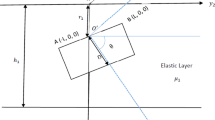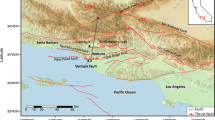Abstract
Rates of shallow slip on creeping sections of the San Andreas fault have been perturbed on a number of occasions by earthquakes occurring on nearby faults. One example of such perturbations occurred during the 26 January 1986 magnitude 5.3 Tres Pinos earthquake located about 10 km southeast of Hollister, California. Seven creepmeters on the San Andreas fault showed creep steps either during or soon after the shock. Both left-lateral (LL) and right-lateral (RL) steps were observed. A rectangular dislocation in an elastic half-space was used to model the coseismic fault offset at the hypocenter. For a model based on the preliminary focal mechanism, the predicted changes in static shear stress on the plane of the San Andreas fault agreed in sense (LL or RL) with the observed slip directions at all seven meters; for a model based on a refined focal mechanism, six of the seven meters showed the correct sense of motion. Two possible explanations for such coseismic and postseismic steps are (1) that slip was triggered by the earthquake shaking or (2) that slip occurred in response to the changes in static stress fields accompanying the earthquake. In the Tres Pinos example, the observed steps may have been of both the triggered and responsive kinds. A second example is provided by the 2 May 1983 magnitude 6.7 Coalinga earthquake, which profoundly altered slip rates at five creepmeters on the San Andreas fault for a period of months to years. The XMM1 meter 9 km northwest of Parkfield, California recorded LL creep for more than a year after the event. To simulate the temporal behavior of the XMM1 meter and to view the stress perturbation provided by the Coalinga earthquake in the context of steady-state deformation on the San Andreas fault, a simple time-evolving dislocation model was constructed. The model was driven by a single long vertical dislocation below 15 km in depth, that was forced to slip at 35 mm/yr in a RL sense. A dislocation element placed in the seismogenic layer under XMM1 was given a finite breaking strength of sufficient magnitude to produce a Parkfield-like earthquake every 22 years. When stress changes equivalent to a Coalinga earthquake were superposed on the model running in a steady state mode, the effect was to make a segment under XMM1, that could slip in a linear viscous fashion, creep LL and to delay the onset of the next Parkfield-like earthquake by a year or more. If static stress changes imposed by earthquakes off the San Andreas can indeed advance or delay earthquakes on the San Andreas by months or years, then such changes must be considered in intermediate-term prediction efforts.
Similar content being viewed by others
References
Allen, C. R., Wyss, M., Brune, J. N., Grantz, A. andWallace, R. E. (1972),Displacements on the Imperial. Superstition Hills, and San Andreas faults triggered by the Borrego Mountain earthquake U.S. Geological Survey Professional Paper787, 87–104.
Brown, R. D. andVedder, J. G. (1967),Surface tectonic fractures along the San Andreas fault. U.S. Geological Survey Professional Paper579, 2–23.
Burford, R. O., Allen, S. S., Lamson, R. J. andGoodreau, D. D. (1973),Accelerated fault creep along the central San Andreas fault after moderate earthquakes during 1971–1973. InProceedings of the Conference on Tectonic Problems of the San Andreas Fault System (eds. Kovach, R. L. and Nur, Amos) (Stanford University Publications in the Geological Sciences13), pp. 268–274.
Chinnery, M. A. (1966a),Secondary faulting—1. Theoretical aspects. Canadian Journal of Earth Sciences3, 163–174.
Chinnery, M. A. (1966b),Secondary faulting—II. Geological aspects. Canadian Journal of Earth Sciences3, 175–190.
Crouch, S. L. (1976),Solution of plane elasticity problems by the displacement discontinuity method. International Journal for Numerical Methods in Engineering10, 301–343.
Ekstrom, G. (1986),A very broad band teleseismic analysis of the August 4, 1985, North Kettleman Hills earthquake. Eos, Transactions of the American Geophysical Union67, 1223.
Erickson, L. (1986),A three-dimensional dislocation program with applications to faulting in the earth. Stanford, Calif., Stanford University, M.S. thesis, 167 pp.
Evans, K. F., Burford, R. O. andKing, G. C. P. (1981),Propagating episodic creep and the aseismic slip behavior of the Calaveras fault north of Hollister, California. Journal of Geophysical Research86, 3721–3735.
Fagerson, S. H., Louie, J. N., Allen, C. R., Sieh, K. E. (1986),Measurements of triggered slip on the southern San Andreas fault associated with the North Palm Springs earthquake. Eos, Transactions of the American Geophysical Union67, 1090.
Goulty, N. R. andGilman, R. (1978),Repeated creep events on the San Andreas fault near Parkfield, California, recorded by a strainmeter array, Journal of Geophysical Research83, 5415–5419.
Jennings, C. W. (1977),Geologic map of California. California Divison of Mines and Geology, California Geologic Data Map Series, scale 1∶750,000.
King, Chi-Yu, Nason, R. D. andBurford, R. O. (1977).Coseismic steps recorded on creep meters a the San Andreas Fault, Journal of Geophysical Research82, 1655–1662.
Matthews, M. V. andReasenberg, P. A. (1987),Statistical methods for investigating quiescence and other temporal seismicity patterns, this volume.
Mavko, G. M. (1982),Fault interaction near Hollister, California, Journal of Geophysical Research87, 7807–7816.
Mavko, G. M., Schulz, S. andBrown, B. D. (1985),Effects of the 1983 Coalinga, California earthquake on creep along the San Andreas fault. Bulletin of the Seismological Society of America75, 475–489.
Nason, R. D. (1973),Fault creep and earthquakes on the San Andreas fault. InProceedings of the Conference on Tectonic Problems of the San Andreas Fault System (eds. Kovach, R. L. and Nur, Amos) Stanford University Publications in the Geological Sciences13, 275–285.
Nason, R. D. andWeerman, J. (1973),A dislocation theory analysis of fault creep events. Journal of Geophysical Research78, 7745–7751.
Poley, C. M., Lindh, A. G., Bakun, W. H., Schulz, S. S. (1987).Temporal changes in microseismicity and creep near Parkfield, California. Nature327, 134–137.
Reasenberg, P. (1985),Second-order moment of Central California seismicity, 1969–1982. Journal of Geophysical Research90, 5479–5495.
Schulz, S. S. (1984),Triggered creep near Hollister after the April 24, 1984, Morgan Hill, California, Earthquake. InThe 1984 Morgan Hill, California Earthquake, (eds. Bennett, J. H. and Sherburne, R. W.), California Division of Mines and Geology Special Publication68, 175–182.
Schulz, S. S., Mavko, G. M., Brown, B. D. (1987),Response of creepmeters on the San Andreas fault near Parkfield to the May 2, 1983, Coalinga earthquake. U.S. Geological Survey Professional Paper, in press.
Sieh, K. E. (1978),Slip along the San Andreas fault associated with the great 1857 earthquake. Bull. Seismol. Soc. Am.68, 1421–1448.
Schulz, S. S., Mavko, G. M., Burford, R. O. andStuart, W. D. (1982),Long-term fault creep observations in central California. Journal of Geophysical Research87, 6977–6982.
Steketee, J. A. (1958),Some geophysical applications of the elasticity theory of dislocations. Canadian Journal of Physics36, 1168–1198.
Wesson, R. L., Jibson, R. W., Morton, D., Campbell, R. H. andNicholson, C. (1986),Interpretation of surface cracks and other fault-line surface deformation associated with the North Palms Springs earthquake of July 8, 1986. Eos, Transactions of the American Geophysical Union67, 1090.
Williams, P., Fagerson, S. andSieh, K. (1986),Triggered slip of the San Andreas fault after the July 8, 1986 North Palm Springs earthquake. Eos, Transactions of the American Geophysical Union67 1090.
Wyss, Max. andBurford, R. O. (1985),Current episodes of seismic quiescence along the San Andreas fault between San Juan Bautista and Stone Canyon California: possible precursors to local moderate mainshocks. U.S. Geological Survey Open-File Report85-754, 366–426.
Author information
Authors and Affiliations
Rights and permissions
About this article
Cite this article
Simpson, R.W., Schulz, S.S., Dietz, L.D. et al. The response of creeping parts of the San Andreas fault to earthquakes on nearby faults: Two examples. PAGEOPH 126, 665–685 (1988). https://doi.org/10.1007/BF00879014
Received:
Accepted:
Issue Date:
DOI: https://doi.org/10.1007/BF00879014




